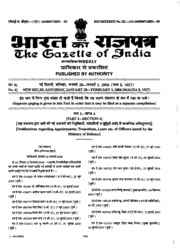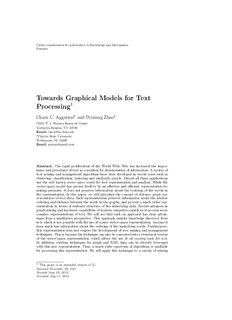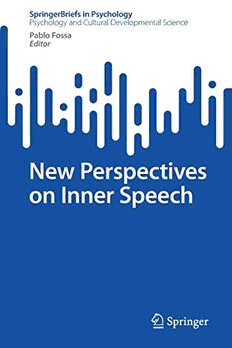
New Perspectives on Inner Speech PDF
Preview New Perspectives on Inner Speech
SpringerBriefs in Psychology Psychology and Cultural Developmental Science Pablo Fossa Editor New Perspectives on Inner Speech SpringerBriefs in Psychology SpringerBriefs in Psychology and Cultural Developmental Science SpringerBriefs present concise summaries of cutting-edge research and practical applications across a wide spectrum of fields. Featuring compact volumes of 50 to 125 pages, the series covers a range of content from professional to academic. Typical topics might include: • A timely report of state-of-the-art analytical techniques • A bridge between new research results as published in journal articles and a contextual literature review • A snapshot of a hot or emerging topic • An in-depth case study or clinical example • A presentation of core concepts that readers must understand to make indepen- dent contributions SpringerBriefs in Psychology showcase emerging theory, empirical research, and practical application in a wide variety of topics in psychology and related fields. Briefs are characterized by fast, global electronic dissemination, standard publishing contracts, standardized manuscript preparation and formatting guidelines, and expedited production schedules. Series Editors Giuseppina Marsico, University of Salerno, Salerno, Italy Jaan Valsiner, Centre for Cultural Psychology, Aalborg University, Aalborg, Denmark SpringerBriefs in Psychology and Cultural Developmental Science is an extension and topical completion to IPBS: Integrative Psychological and Behavioral Science Journal (Springer, chief editor: Jaan Vasiner) expanding some relevant topics in the form of single (or multiple) authored book. The Series will have a clearly defined international and interdisciplinary focus hosting works on the interconnection between Cultural Psychology and other Developmental Sciences (biology, sociol- ogy, anthropology, etc). The Series aims at integrating knowledge from many fields in a synthesis of general science of Cultural Psychology as a new science of the human being. The Series will include books that offer a perspective on the current state of developmental science, addressing contemporary enactments and reflecting on the- oretical and empirical directions and providing, also, constructive insights into future pathways. Featuring compact volumes of 100 to 115 pages, each Brief in the Series is meant to provide a clear, visible, and multi-s ided recognition of the theoretical efforts of scholars around the world. Both solicited and unsolicited proposals are considered for publication in this series. All proposals will be subject to peer review by external referees. Pablo Fossa Editor New Perspectives on Inner Speech Editor Pablo Fossa Universidad del Desarrollo Santiago, Chile ISSN 2192-8363 ISSN 2192-8371 (electronic) SpringerBriefs in Psychology ISSN 2626-6741 ISSN 2626-675X (electronic) SpringerBriefs in Psychology and Cultural Developmental Science ISBN 978-3-031-06846-1 ISBN 978-3-031-06847-8 (eBook) https://doi.org/10.1007/978-3-031-06847-8 © The Editor(s) (if applicable) and The Author(s), under exclusive license to Springer Nature Switzerland AG 2022 This work is subject to copyright. All rights are solely and exclusively licensed by the Publisher, whether the whole or part of the material is concerned, specifically the rights of translation, reprinting, reuse of illustrations, recitation, broadcasting, reproduction on microfilms or in any other physical way, and transmission or information storage and retrieval, electronic adaptation, computer software, or by similar or dissimilar methodology now known or hereafter developed. The use of general descriptive names, registered names, trademarks, service marks, etc. in this publication does not imply, even in the absence of a specific statement, that such names are exempt from the relevant protective laws and regulations and therefore free for general use. The publisher, the authors and the editors are safe to assume that the advice and information in this book are believed to be true and accurate at the date of publication. Neither the publisher nor the authors or the editors give a warranty, expressed or implied, with respect to the material contained herein or for any errors or omissions that may have been made. The publisher remains neutral with regard to jurisdictional claims in published maps and institutional affiliations. This Springer imprint is published by the registered company Springer Nature Switzerland AG The registered company address is: Gewerbestrasse 11, 6330 Cham, Switzerland Series Editors’ Preface On the Borders of Inner Speech This book is a tour de force that starts from the observable act of speaking and finds its winding road to the mysteries of inner speech. The reader of this small volume can trace on almost every page the tension between the ease of observing external speaking and the effort to penetrate its internal counterpart. The latter effort is indeed very substantial—and the readers of this volume can observe as the well- meaning authors perform interesting intellectual dances at the doorstep of the cabi- net of curiosities of the inner speech—fearing to enter. We see the reason for this fear in the very tentative return of psychology’s methodology to the recognition of introspection as the central method (Bühler, 1951; Valsiner, 2017). Thus, the reader may come to examples close to reporting introspective evidence by Chap. 5, for example, in the form of the following account of witnessing a sports accident: The feeling that something was about to happen was growing inside me, somehow I knew that it was going to end with the guy falling, and he kept going up, and he arrived to the higher point and then he fell and it was like: ‘aaaah!’ (emphases added) The critically relevant feature of this (and all other) verbal account is the reference to verbally indescribable vague experiences (“something,” “aaah”). This vagueness of presentation is natural—as our inner speech has to relate to the anticipated near future and is therefore indiscriminate. The move into imagery fits the totality of such anticipatory focus better than narration. Thus, the abbreviation of meaning in the case of inner speech is polymodal and cutting across borders of sensory modalities. The guru figure of inner speech researchers—Lev Vygotsky—made it very clear that the inner speech entails abbre- viated speech forms that begin to lose the nature of our ordinary external speech. Inner speech continually creates a field of meanings, a psychisches Feld, which differs from the external situation; this is the strength of abstraction and freedom — we are incapable of changing the field of forces and the external Aufforderungscharakter, but by changing the inner field, we change its impact on us also from the outside. The problem of will is trans- ferred from outside inwards, from the plane of behavior to the plane of consciousness: the v vi Series Editors’ Preface creation of inner fields, for which the presence of meaningful speech is indispensable (Zavershneva & van der Veer, 2018, p. 336). The crucial feature of inner speech is the liberation of thought from language through abstraction and generalization. The “speaking ape”—as the human beings are in their public worlds—becomes a contemplating human as she follows the Janet-Vygotsky Law (of constructive transfer of relevant meanings from external to internal fields). In inner speech, the synesthesia between different forms of meaning construction media becomes established in a rapid process of synthesis. The access roads to these even if we had a direct visibility of the inner subjective processes would still not be open to purely language-focused methods (narrative analysis, conversational analysis, discourse analysis) since the very language used in external speech is transforming into an abstracted abbreviated Gestalt of musical, visual, or tactile kind. Literally, the phenomenon of inner speech “runs away” from the fixed categories of methods that are applicable to external speech. Demonstration of how the phenomena of inner speech escape from our standard methods in psychology can be found from an unexpected source—Alexander Luria’s account of the man with phenomenal memory capacities (Luria, 1987). In his effort to find out how such huge memory capacity works, Luria (in December 1937) gave him the first four lines of Dante’s Divine Comedy to remember. Despite knowing no Italian, the mnemonist remembered the lines perfectly and repeated them with very good intonation. The first line Nel mezzo del cammin di nostra vita was reported by the mnemonist in retrospect as intense synesthetic effort involving visualizations that supported the oral external speech: Nel – “I was paying my membership dues when there, in the corridor, I caught sight of the ballerina Nel’skaya” Mezzo – “I myself am a violinist, what I do is to set up an image of a man, togerger with (Russian vmeste) Nel’skaya, who is playing the violin” (Luria, 1987, p. 45) Del – “There is a pack of Deli Cigarettes near them” Cammin – “I set up an image of a fireplace (Russian kamin) close by” Di – “Then I see a hand pointing toward a door (Russian dver)” Nostra – “I see a nose (Russian nos); a man has tripped and, in falling, gotten his nose pinched in the doorway” Vita – “He lifts his leg over the threshold, for a child is lying there, that is, a sign of life— vitalism” (Luria, 1987, p. 46) The revelation of the synesthetic scenario creation by the creator illustrates the impossibility of study of inner speech by way of linguistic methods. This leads to a major claim—methods of the study of inner speech need to be polyphonic, and transcend the borders of images in different modalities. As a compilation of theoretical and empirical advances related to inner speech phenomenon, this book may provoke new debates and ideas. The editor Pablo Fossa has already succeeded in taking on the challenge to discuss in a new fashion one of the major contributions of Vygotsky to the modern psychology that of the ground- ing of human thought in what is not immediate intelligible (Kozulin,1999). In the inner speech, one of the most intimate and important psychological process is Series Editors’ Preface vii taking place: the generation of thoughts in the form of words meanings. The fasci- nating process of a thought that becomes itself out of what is not yet thought is what this volume is ultimately about. It is remarkable that a young group of scholars, mainly located in Latin America and masterfully led by Pablo Fossa, are pursuing one of the most interesting of Vygotsky’s lines of inquiry. This is a very promising move in the current academic panorama since the 1960s that may lead to new understanding of how inner speech constitutes a space of self-other dialogicity, establishing a fundamental link between individual consciousness and cultural dimension. Tartu, Estonia Jaan Valsiner Salerno, Italy Giuseppina Marsico May 2022 References Bühler, K. (1951). On thought connections. In Rapaport, D. (Ed.), Organization and pathology of thought. Columbia University Press. Kozulin, A. (1999). Vygotsky’s psychology: A biography of ideas. Harvard University Press. Luria, A.R. (1987). The mind of a mnemonist. Harvard University Press. Valsiner, J. (2017). From methodology to methods in human psychology. Springer. Zavershneva, E, & van der Veer, R. (Eds.) (2018). Vygotsky’s notebooks. Springer. Contents 1 Inner Speech: The Private Area to Remember, Play, and Dream . . . . 1 Pablo Fossa Part I Theoretical Advances on Inner Speech 2 Reflective and Pre-reflective Inner Speech . . . . . . . . . . . . . . . . . . . . . . . 9 Pablo Fossa and Cristóbal Pacheco 3 The Otherness in the Constitution of the Psyche: Arguments from Psychoanalysis and Cultural Psychology . . . . . . . . . . . . . . . . . . . 23 Raffaele De Luca Picione and Maria Francesca Freda Part II Empirical Advances on Inner Speech 4 Expressiveness and Psychic Internality: The Use of Online Diaries in the Contemporary Forms of Life . . . . . . . . . . . . . . . . . . . . . . . . . . . . 43 Marina Assis Pinheiro, Roberta de Sousa Mélo, and Clarissa Dubeux Barros 5 An Experimental Phenomenological Approach to the Study of Inner Speech in Empathy: Bodily Sensations, Emotions, and Felt Knowledge as the Experiential Context of Inner Spoken Voices . . . . . . . . . . . . . . . . . . . . . . . . . . . . . . . . . . . . . . . 65 Mayte Vergara, Ignacio Cea, Jorge Calderón, Alejandro Troncoso, and David Martínez-Pernía Part III Conclusion 6 The Inner Other: Who Speaks When I Speak to Myself in Silence? . . . . . . . . . . . . . . . . . . . . . . . . . . . . . . . . . . . . . . . . . . . . . . . . . 83 Pablo Fossa Index . . . . . . . . . . . . . . . . . . . . . . . . . . . . . . . . . . . . . . . . . . . . . . . . . . . . . . . . . . 87 ix
The list of books you might like

The Sweetest Oblivion (Made Book 1)

As Good as Dead

Do Epic Shit

Shatter Me Complete Collection (Shatter Me; Destroy Me; Unravel Me; Fracture Me; Ignite Me)

Yerbas medicinales Argentinas : breves apuntes de las propriedades de 200 de las mismas e indicaciones para su uso

The Gate
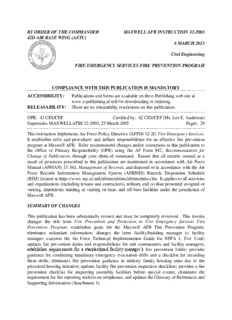
BY ORDER OF THE COMMANDER MAXWELL AFB INSTRUCTION 32-2003 42D AIR BASE WING ...

Cento Anni di Ricerca Petrolifera(1)

Live and let live

Structured glass-fiber catalysts

Vitis vinifera subsp. vinifera cv. Marselan
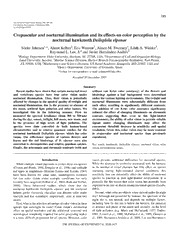
DTIC ADA519442: Crepuscular and Nocturnal Illumination and Its Effects on Color Perception by the Nocturnal Hawkmoth Deilephila elpenor

NOTAS SOBRE A TEORIA DOS PRINCÍPIOS DE ROBERT ALEXY Natália Braga Ferreira NOTES ...
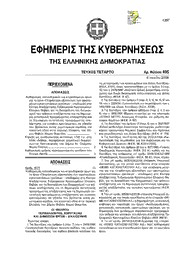
Greek Government Gazette: Part 4, 2006 no. 495

Reiki for Dummies

Tomato container gardening: 7 easy steps to healthy harvests from small spaces

Hermanas de sangre
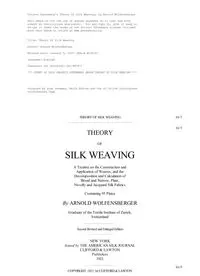
Theory of Silk Weaving

Inside the Star Wars empire: making magic at George Lucas's industrial light and magic
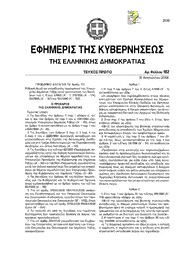
Greek Government Gazette: Part 1, 2006 no. 182
